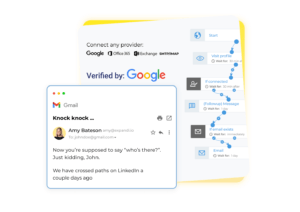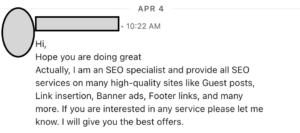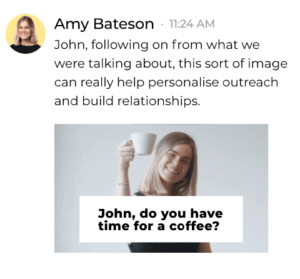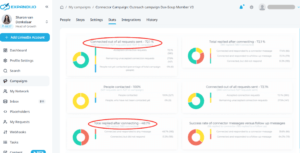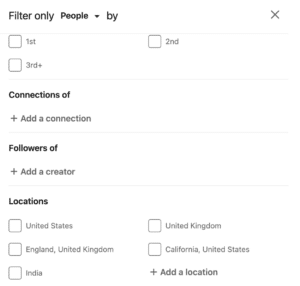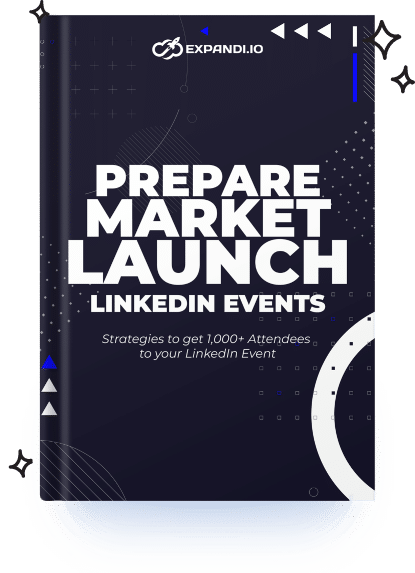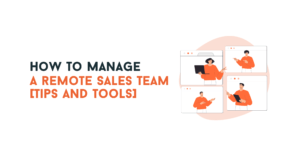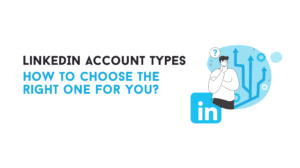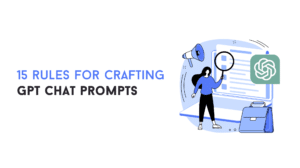When it comes to outreach, more doesn’t always mean better. While some people believe that the number of leads is the thing that matters the most, we prefer to focus on something else: the number of good-fit leads who are ready to buy.
As a salesperson, your resources are limited and you should focus them on people and companies with whom you have higher chances of succeeding and closing the sale. You not only have to make sure they fit into your ideal customer profile but also that they’re in the right stage of their customer journey.
In this article, we’ll explain everything you need to know about lead qualification while making inbound sales.
Table of Contents
What Are Qualified Sales Leads?
From lead to a client: Outbound funnel
The outbound funnel is a bit different from a traditional sales funnel. You have to guide your potential clients by asking them the right questions at the right time, to determine their qualifications.
While the ultimate goal of lead qualification is to identify the most promising prospects, there are significant differences between qualifying inbound and outbound leads. In the case of inbound leads, they have already expressed interest and initiated contact with the business, indicating some level of pre-qualification.
The focus is on understanding their needs, assessing their fit, and nurturing them toward conversion.
However, with outbound leads, the business has more control over who they reach out to. Outbound lead qualification involves defining specific criteria and actively identifying potential leads who meet those criteria. It requires verifying contact information, conducting research, and tailoring outreach to engage with relevant prospects.
Here’s what that decision-making process looks like:
- Contacts: Start by assessing the contacts you could reach out to, to see whether they fit your outbound criteria.
- Verified contacts: Now that you have a list of contacts that potentially fit your outbound criteria, you can reach out to your verified contacts.
- MQL: Marketing-qualified leads are people who reply to your message. Now, it’s time to schedule an exploratory call to see if they’re a good client for us.
- SQL: Sales-qualified leads are MQLs we talked to and concluded they could be a good client.
- Client: The final step is to convert SQLs into paying clients.
How to qualify leads in different stages
Outbound lead qualification involves ongoing qualification at each stage of the outbound process, from initial targeting and contact verification to messaging customization and evaluating qualification criteria.
To qualify contacts look at the job titles of the contacts to determine if they hold positions that are relevant to your offerings. Consider whether their roles indicate decision-making authority or influence over purchasing decisions, such as SEO, CFO, COO, Director of Sales, etc.
As for the company you need to examine company details, assess factors such as industry, company size, geographic location, and any other relevant characteristics that align with your target market.
Once you have determined the contact, you need to verify them by comparing the contact details you have collected with multiple reliable sources to confirm their accuracy. This can include cross-referencing information from company websites, professional social media profiles (e.g., LinkedIn), business directories, or industry-specific databases.
Check the lead’s activity on LinkedIn or use email verification tools that can verify the validity of email addresses. These tools check the syntax, domain, and deliverability of email addresses to ensure they are active and reachable.
Before contacting your verified leads, you need to identify their pain points and needs. Stay updated on industry news, trends, and challenges. This helps you identify common pain points and needs your target audience might be experiencing.
Analyze feedback, testimonials, and case studies from your existing customers. Look for common pain points or challenges your offerings address, and compare them with the contacts’ profiles to identify potential alignment.
Based on the assessment of the contacts, prioritize those who align most closely with your outbound criteria and have the highest potential for interest in your offerings.
Importance of qualifying leads in outbound sales
The biggest benefit of lead qualification is saving time and generating a bigger revenue with the same amount of time and effort.
We can illustrate this with a real-life example. Let’s say you have 100 people who replied to your outbound message. Seems like a great number, doesn’t it?
Now, there are two paths. You could either spend too much time focusing on everyone, including those who don’t need your solution right now or those that are not decision-makers. As a result, your sales cycle would be long and your close rate lower because you weren’t focusing on the right people.
On the other hand, you could qualify your leads and say “No” to everyone who isn’t qualified. Yes, it feels like your sales pool is smaller now. You no longer have 100 people, you probably have 50 left.
However, if you focus on closing the most valid and relevant leads, you’ll end up with a better sales cycle and a much higher close rate.
Not only that. Since those leads went through your qualification, there’s a huge chance that their ARPA (Average Revenue Per Account / Deal) will be higher. In the same period of time, you were able to generate a much higher revenue just by prioritizing the people you focus on.
The lead qualification process might seem like a lot of work, but it actually saves your sales and marketing teams a lot of time in the long run. They get to streamline the sales process and direct their efforts toward leads that seem the most likely to buy, using the pre-established criteria.
Criteria for qualifying leads
Lead qualification involves determining whether your leads meet the following criteria:
- Interest: It’s important to determine their level of interest. You don’t want people who are just mildly interested in your offer but those who are ready to commit. Are they interested in learning more about our product or service?
- Need: Showing interest is not enough. You want to find people and companies who actually need your product because it can help them solve a particular problem. How big are their pain points? Are you sure your product can help them solve their problems/achieve their goals?
- Budget: You need to make sure that your potential customers can afford your product. You can ask them how much they’re paying for similar solutions, if they’re already using them, or what price range seems reasonable to them.
- Time: You have to make sure they’re ready to buy the product now. Ask them questions to determine where are they in the sales funnel at the moment and is there anything that prevents them from making a purchase now.
- Authority: Does the person you’re talking to have purchasing authority or there are multiple decision-makers? If they’re not a decision-maker, you can ask them to connect you with decision-makers in their company.
Qualifying and Nurturing Leads
Lead qualification process
You have a limited amount of resources: time, energy and people in your sales team. That’s why it’s essential to find an effective way to filter and qualify leads to make sure you’re focusing your efforts on people who are most likely to purchase your product.
Qualifying leads will also help you better understand your customers and their problems and come up with even better ways to present your product or service.
Here’s a step-by-step description of the lead qualification process:
- Define your ideal customer profile
- Capture lead information
- Initial lead scoring
- Engage and assess lead behavior
- Qualify based on explicit data
- Lead scoring refinement
- Sales and marketing alignment
Strategies for qualifying leads
The first part is to make sure we have marketing-qualified leads. Being aware of a certain problem is not enough. To qualify leads, you need to filter out people who actually have purchasing intent.
The best way to do so is through a lead-scoring process. The process might look different in every industry, but the idea is to identify important characteristics and give your leads a certain number of points for every characteristic they have. The next step is to set a scoring threshold, the minimum score required for a lead to be considered an MQL.
Here are some lead-scoring tips:
- They get a certain amount of points depending on their industry
- They get a certain amount of points depending on their seniority and the role they play in the decision-making process
- They get a certain amount of points based on actions they show they have a purchasing intent (visiting a particular page on your website, downloading a guide, watching a demo, etc.)
After that, your sales rep should book a call with a marketing-qualified lead to see if they’re ready to start the purchasing process.
Here are some of the most effective lead qualification frameworks you can use:
BANT
BANT stands for four important factors – budget, authority, needs and timeline.
- Budget: Does our product or service fit into the prospect’s purchasing budget?
- Authority: Is the prospect authorized to make a purchasing decision or there are other decision-makers that are also involved?
- Needs: How much does the prospective customer need our product on a scale from 1 to 10?
- Timeline: Where are they in their customer journey? Are they ready to purchase the product?
CHAMP
This framework focuses on determining your prospect’s goals and priorities.
- Challenges: What are your prospect’s challenges, what do they want to solve by purchasing your product?
- Authority: What does the decision process look like in their company? Who is the purchasing authority?
- Money: What is their budget for this kind of product or service?
- Prioritization: How big of a priority is solving this problem and making and actual purchase?
ANNUM
ANNUM is a lead qualification framework similar to BANT, but it focuses on identifying decision-making authority first.
- Authority: Is the person we are talking to qualified to make purchasing decisions?
- Need: Does the company really need our product or service?
- Urgency: Do they need a solution now? The bigger the pain points, there’s more chance they need a solution urgently.
- Money: Do they have a budget required?
Each lead qualification framework is there to help you figure out whether you have a sales-qualified lead or not. Here are some questions you can fill up in the CRM to help you assess each MQL and determine the next steps:
- Does this lead have the authority to make a purchasing decision?
- What is their job title?
- Does this lead’s company has the budget to purchase our product?
- What are their specific needs and pain points?
- Does our product addresses those needs effectively?
- Does the lead have a specific timeframe for solving a problem?
- Is there a sense of urgency?
These questions should help you determine whether you have a sales-qualified lead or not.
A) If they are SQL, you should push them to the sales pipeline.
B) If they’re NOT SQL, you should proceed by adding them to a lead nurturing campaign.
C) During the call, you may discover that some leads aren’t a good fit even though they seemed great on paper. You can label them as disqualified leads and not proceed with moving them down your sales funnel.
Lead nurturing process
Not all leads will be ready to buy, but that doesn’t mean they should be disqualified if they fit your other lead criteria. Instead, you should start nurturing them with helpful content that will provide value and help them get familiar with your product.
Let’s say you had a call with a lead that fits all your criteria but isn’t ready to buy because they don’t need your solution right now. Is it a lost deal? It doesn’t have to be! What we suggest instead is asking them whether it’d be ok to reconnect next quarter. The majority of people will agree. In that case, do the following two things:
- Add the task to your CRM to contact this person in 2.5 months
- Add them to your light newsletter / lead nurturing sequence
So, what is exactly a lead nurturing sequence? It’s usually an email newsletter that you use to share valuable content like webinars, ebooks, whitepapers and so on, to stay in touch with your potential customers, educate them about your product or service and be there when they’re ready to make a decision.
Lead nurturing campaigns have many benefits:
- They allow you to build meaningful relationships with your leads
- They help you build trust and authority
- They’re a great way to stay in touch with your leads until they’re ready to buy
- They can help you with the lead-scoring process, based on your lead’s engagement
Here are some examples of the campaigns you can use:
- Welcome Email Series: When a new lead subscribes to your newsletter or signs up for your service, you can send a series of welcome emails to introduce your brand, provide helpful information, and guide them towards taking the next step. This series can include a thank you email, an overview of your products/services, customer testimonials, and exclusive offers.
- Drip Email Campaigns: Drip campaigns are a series of automated emails sent at specific intervals to engage leads over time. For example, you can create a campaign that sends educational content related to your industry, such as blog posts, case studies, or whitepapers. Gradually, you can introduce product-specific emails highlighting the benefits and features, leading to a call-to-action.
- Event/Webinar Campaign: If you’re hosting an event or webinar, you can create a lead nurturing campaign to promote the event, provide relevant details, and encourage registrations. After the event, you can send follow-up emails with key takeaways, additional resources, and a request for feedback or a call-to-action related to your products/services.
- Lead Scoring Campaign: Implement a lead scoring system based on specific criteria like engagement level, website visits, content downloads, or email interactions. Once a lead reaches a certain score, trigger a targeted campaign with personalized content tailored to their interests and needs. This helps in building a deeper connection and guiding them towards conversion.
- Re-engagement Campaign: If you have leads who have gone dormant or haven’t engaged with your emails for a while, a re-engagement campaign can help revive their interest. Send a series of emails offering exclusive discounts, new updates, or inviting them to provide feedback. By showing that you value their opinion and offering incentives, you can rekindle their interest.
Remember, the key to effective lead nurturing campaigns is personalization, relevance, and providing value to your leads.
The Outbound Sales Process
Now, let’s go one step back and see what needs to happen before qualifying leads.
Overview of the outbound sales process
The outbound sales process involves reaching out to potential customers and offering them a solution for their assumed problem.
The biggest difference between the inbound and outbound approach is that inbound sales are based on attracting your leads with your content (pull marketing) while outbound sales require you to reach out to your prospects first and communicate your message (push marketing).
Many people confound outbound sales with cold calls and pitching your product to a complete stranger, but it doesn’t have to be like that. A well-plan outbound strategy consists of different stages that serve to build a relationship with potential customers and warm them up before you pitch your product.
Types of outbound lead generation
Here are the tools you can use for outbound lead generation:
- LinkedIn: Thanks to its filters and automation tools, LinkedIn B2B lead generation could be the fastest and most accurate way to reach your leads.
- Outbound emails: Many B2B companies use email as a first contact and way to introduce their product to a potential customer. Check out the most effective email sequence for outreach.
- Cold calling: This technique is usually combined with other lead generation methods, or used as follow-up.
Strategies for Generating Qualified Sales Leads in Outbound Sales
In outbound sales, you need to walk a person through different stages before they become a client. Here are the stages of contact:
- The first step is to identify potential leads.
- The second step is to reach out to them by sending them a cold email or LinkedIn message.
- Based on their reply, you can decide what is the next step. Whether they don’t fit your customer profile and you want to stop the process or you want to further qualify them.
- The next step is scheduling a sales call where you get to qualify a lead and see whether they’re a good fit for your product and service.
- The final step is closing the deal and converting them into a paying customer.
Identifying your ideal customer profile
Some sales persons skip this step and see it as a waste of time, but it’s actually saving you time in the long run. If you don’t take your time to figure out your ideal customer profile before you start outreach, you won’t attract qualified leads.
Yes, you may get some replies, but they probably won’t be relevant and it’ll make your sales cycle longer and more complicated.
Here are some questions to help you identify your ICP:
- In what industry is your ideal prospect’s company?
- What is their location?
- What’s the company size?
- What are their pain points, what problems they might be facing?
- What are their objectives?
- Who are the decision-makers in that company?
- What is their job title?
Creating targeted and personalized messaging
The first rule for writing a successful outbound message is to make it about your customer, and not about your company. Address their problems and show them how your product can be of service and help them get the desired outcome.
To do this effectively, you need to take time and do research about the company you’re contacting. Show some genuine interest to learn more about the company and it’ll make you stand out from other sales reps who are sending generic messages.
This is something you shouldn’t do:
Another good idea is to refer to something your lead has posted or commented and to continue the conversation from there. Check out the example below:
Expandi allows you to create hyper-personalized messages that will make you stand out in your prospect’s inbox.
Leveraging multiple channels for outreach
Your outreach channels will depend on where your target audience is. However, you’ll get better results if you opt for a multi-channel approach. Here are some ideas:
- LinkedIn – When it comes to B2B sales, there’s no better place than LinkedIn. It allows you to filter prospects using different criteria (industry, location, job title, etc.)
- Email – If you’re wondering where to find your prospect’s email, it’s not that hard! First, many people have their email on their LinkedIn profile. If not, you can find them on the company’s website or try to guess using their name and the company’s domain. Finally, there are tools that can help you scrape emails from LinkedIn.
- Cold calling – It may seem old-fashioned, but it can make you stand out from other sales reps, especially if you combine calls with a follow-up message on LinkedIn.
Using technology to streamline the process
Scaling your B2B sales process in order to reach more qualified leads can be time-consuming if done manually. Thankfully, there are some great automation tools that can help you reach more people.
Expandi can be used both for LinkedIn and email outreach. You can connect with your prospects and send messages at scale and schedule follow-up messages. There are also smart sequences that trigger sending different messages based on the prospect’s behavior.
The best part is that Expandi mimics human behavior, for example, sending messages in non-regular time intervals, so that it feels like a natural conversation to your prospect.
Using a multi-channel approach that combines LinkedIn messages and emails can triple your response rate. Start with a LinkedIn message, that you can personalize with memes and pictures.
Use our Smart sequences to determine what happens next. If the lead doesn’t answer during the time you specified, you can schedule an automatic follow-up message or email.
A lot of people don’t check their LinkedIn often or they get a lot of InMail messages and that’s why this approach will make you stand out.
Measuring Success and Continuously Improving
Metrics to track for outbound sales success
Here are the most important metrics to track, based on the outbound channel you choose:
- Open rate – If your email open rates are low, you can experiment with catchy subject lines. If this happens on LinkedIn, try to personalize the first part of the message that the person sees in their inbox.
- Response rate – To increase it, you can experiment with the content of your messages and make sure they’re customer-centric: use hyper-personalization, emphasize their pain points, add stronger CTAs and create a sense of urgency. Make sure to also measure the rate of positive responses.
- CTR – Whether we’re talking about PPC ads or messages that contain links, make sure to measure the percentage of people who actually click on them.
- MQL rate – What percentage of your prospects turned out to be marketing-qualified leads? If the percentage is low, you may need to change the audience or reevaluate your buyer personas.
- MQL to SQL conversion rate – What percentage of MQLs become sales-qualified leads? If the percentage is low, again, you may need to change the audience or target people that are further down the sales funnel. Also, consider additional training for your sales team.
- Conversion rate – Monitoring your conversion rate could help you identify the traits that your best customers have in common so that you can look for other leads with similar characteristics.
Importance of analyzing data and continuously improving
If you don’t know where to start, think of this as a learning experience for your marketing and sales team. You’re here to learn more about your potential customers and get a better understanding of their buyer behavior.
Of course, it’s essential to track metrics, compare outreach results and then make data-driven decisions about your next step.
Your goal should be to test different strategies and see what’s working in your industry. Some tools allow you to do A/B testing to see what kind of messages resonate better with your target audience.
Examples of successful outbound sales campaigns
Stormbreaker Digital: 70% response rate
Strombreaker Digital is a B2B lead generation agency, and working in the B2B, they rely on LinkedIn a lot. They experimented with different sales prospecting tools and sales engagement platforms but in the end, they choose Expandi because it allowed them to send hyper-personalized messages at scale.
Our tool not only allowed them to add a prospect’s name and create different scenarios based on the prospect’s response, but they were also able to create personalized images and GIFs that improve response rate and boost engagement.
As a result of this strategy, their response rate went to almost 70%, which is amazing, considering that most cold email marketers consider a 10-15% response rate a success.
BAMF: Growing client base 5x
This marketing agency used Expandi to scale their business and get 5x more clients in only one year. They believe that the key to their success was an omnichannel approach because they combined LinkedIn automation and cold emails to reach the leads.
They integrated the data they gathered into their CRM software, allowing their sales team to proceed with the lead qualification process, based on accurate information.
Reaching Out to Selected Contacts and Using LinkedIn Automation Tools
Importance of reaching out to the right people
They say that outreach is the number’s game. However, that doesn’t mean you should reach out to everyone because that would be a waste of your resources. Instead, the goal is to qualify leads and you can even create your own lead-scoring model to help you rank your leads and then reach out to the highest-ranking lead. This approach will help you increase the number of responses you get and your conversion rate.
Strategies for finding and selecting the right contacts
LinkedIn may be the best tool to find leads that fit your ideal customer profile because there are many advanced filters you can use:
- Location
- Industry
- Company size
- Job title
- Keywords on their profile
- Boolean search
If you want to ask your existing customers for referrals, you can search LinkedIn for people that meet the above criteria but are also connected to your customer and then ask them to recommend you to those people.
Finally, you can also scrape data from LinkedIn events to get emails of people who may be interested in your product.
Check out this guide on how to build a prospect list before omnichannel outreach.
Overview of LinkedIn automation tools and their benefits
LinkedIn automation tools allow you to precisely target your leads and create outbound campaigns to get connected and build relationships with a high number of leads. Here is how you can benefit from using them:
- They can help you connect with more people than you could do by manually sending requests.
- They save your marketing and sales teams a lot of time that can be used for creating strategy and planning.
- They save you money because you can do outreach at scale even if you’re a small agency or even a one-man business.
- You can automate and schedule your messages so you never forget to follow up.
- They allow you to track many different metrics and give you insights that can help you understand your leads better.
- They help you overcome some of LinkedIn’s limitations.
- Some tools like Expandi, allow you to combine LinkedIn and email outreach for even better results.
Best practices for using LinkedIn automation tools
Here are a couple of quick tips:
- When sending a connection request, always add a personalized note.
- Don’t send generic messages, always research a company and personalize them as much as you can.
- Schedule follow-up messages in irregular intervals, so that they mimic real human conversation (not all tools have this option, but Expandi does).
- Split your leads into different categories and do A/B testing.
- Respect Linkedin’s limits, to avoid getting banned. LinkedIn has limits on how many connection requests you can send daily and how many actions in total you can take. With advanced tools like Expandi, you don’t have to think about that, because we’ve integrated smart limits to make sure you don’t get banned.
Conclusion
By now, you should have a better understanding of lead qualification and its importance in the overall outbound sales process.
Why would you do this process manually and let your sales teams bother with spreadsheets when there’s an easy way to automate it and get better results much quicker?
We’ve got you covered. Expandi can help you skyrocket both LinkedIn and email outreach and get sales-qualified leads. Sign up today and see the first results in 24 hours.
FAQ
What are qualified leads examples?
A qualified lead is a person who is interested in your product, can afford it and it’s ready to make a purchasing decision.
How do you determine sales-qualified leads?
There are various frameworks that can be used to qualify leads, but it’s important that they meet the following criteria:
- Showing a high level of interest
- Needing your product to solve a particular problem
- Having an adequate budget for it
- Being ready to start the sales process
- Having purchasing authority
What is MQL vs SQL vs SAL?
The biggest difference is their position in the sales funnel.
- MQLs are interested in a particular product but they show no intention of buying it, because they’re still at the top of the funnel
- SALs are MQLs that meet the criteria for qualifying leads on paper but haven’t talked to your sales team yet
- SQLs are leads that have been qualified by your sales team and are ready to continue to the purchasing process

